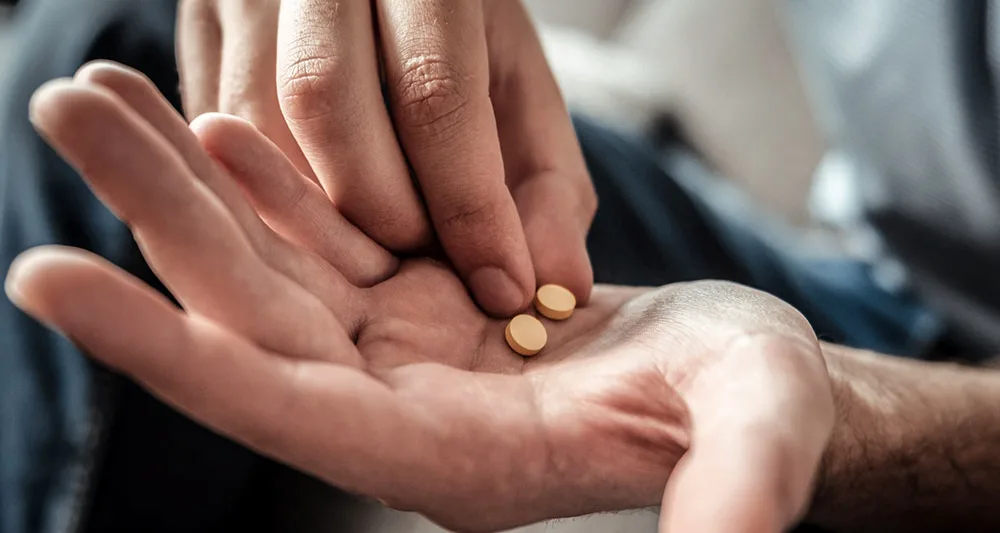Important safety information
What should you know before taking valacyclovir.
Take control of outbreaks and decrease the risk of transmission with FDA‑approved medication.
Outbreaks and preventative treatments available, if prescribed
100% online with no in-person visit
Medical provider will get back to you within 24 hours
Free shipping in discreet packaging
*YOUR FIRST ORDER. FINAL PRICE DEPENDING ON PRESCRIBED TREATMENT PLAN.
About genital herpes
Only 20% of people with genital herpes know they have it.
Genital herpes, caused by viruses HSV-1 or HSV-2, causes painful ulcers on and around the genitals in both men and women. Herpes is a common sexually transmitted infection (STI).
Yes. FDA-approved medication is available to treat and suppress outbreaks as well as reduce the risk of transmission. A Ro-affiliated provider will answer your questions about treatment and create a personalized treatment plan for you.
What to expect
Valacyclovir will get to work as soon as the medication is in your system, but the time it takes to see noticeable results varies from person to person.
Help with side effects: If you experience side effects, message your provider and they’ll help determine if a different medication or dose is better for you.
Today
Answer some questions about your medical history and symptoms in the online provider evaluation, which typically takes 20 minutes to complete. Your first outbreak must be diagnosed by an in-person medical provider to be eligible for treatment through the Ro platform.
Typically within 24 hours
A licensed healthcare provider will review your information and find the best treatment plan for you.
4-7 days
If prescribed, your medication will ship in discreet packaging.
You’re on your way
We're here for you from beginning to end. You may need to adjust your medication to get optimal results. That's why members always get free, unlimited follow-ups with their provider.
Valacyclovir is used for treating cold sores and genital herpes. Valacyclovir starts to work immediately in the body after you take it. It can help shorten the duration of an outbreak and reduce the risk of transmitting the virus to others.
Valacyclovir acts through multiple mechanisms to prevent the replication of herpes DNA, preventing the virus from making copies of itself, which is how the virus causes outbreaks. Valacyclovir is active against HSV-1, HSV-2, VZV (the virus that causes chickenpox and shingles), and to a lesser extent, other herpes viruses, like CMV. When viral DNA is prevented from replicating, the virus cannot multiply and infect uninfected cells. This is how valacyclovir works:
Stops or shortens outbreaks of genital herpes and oral herpes
Prevents outbreaks of genital and oral herpes
Decreases the risk of infecting an uninfected partner
Once in the body, valacyclovir starts to work almost immediately. Since it specifically attacks the DNA replication process, it will only attack herpes viruses that are multiplying. While it starts to work on an active infection very quickly, it will not fight the inactive virus hiding in the nervous system.
Nevertheless, if taken daily and used in combination with safe sex practices, it may reduce the number of outbreaks a person might experience by 54% and reduce the risk of transmitting herpes to a partner by about 50%. Taken at the earliest feeling that an outbreak is on the verge of occurring, valacyclovir may either stop the outbreak or shorten how long it will last. Remember, with valacyclovir treatment for herpes, the earlier you take it after the symptoms appear, the better.
While it goes to work within hours of taking the medication, the symptoms and sores of an outbreak may take days to heal, and the virus can stay active throughout the healing process.
Valacyclovir is an antiviral medication that is used to treat oral herpes and genital herpes, which are caused by herpes simplex viruses 1 and 2 (HSV-1 and HSV-2).
Common side effects of valacyclovir include headache, nausea, and stomach pain. More serious side effects can occur and are more likely if you have a weakened immune system or are elderly.
For more comprehensive information on side effects that can occur with valacyclovir, see full Important safety information here.
Valacyclovir comes in two doses, 500 mg and 1000 mg tablets. Although there are only two doses, there are several ways to use the medicine for different indications. Remember that these doses may need to be changed for people with specific conditions, such as kidney problems. If you’re prescribed valacyclovir, take it according to your prescriber’s instructions.
For genital herpes:
To Treat Or Abort An Outbreak When There Are Early Symptoms (Prodrome) Some patients use valacyclovir to stop an outbreak. Whether oral or genital, people can take medication when their specific prodrome (pre-outbreak symptoms) tells them an outbreak is on the horizon. The medication often stops an outbreak; when it does not, it can shorten and make an outbreak milder than it might have been otherwise.
To Prevent Outbreaks When There Are No Symptoms But Outbreaks Are More Likely Patients also learn the life circumstances or behaviors that lead to more outbreaks. For some, a lack of sleep, increased alcohol intake, another illness, stress, too much sunlight, irritation, or anything that can affect one’s immunity can spur an outbreak. They know when they are more likely to have an outbreak due to their circumstances. They can avoid their triggers, but they also might want to take medication preventatively, knowing when they are more vulnerable.
To Suppress Outbreaks For An Extended Period You can take valacyclovir to reduce your chance of having an outbreak. The classic example would be during your honeymoon, going on vacation, starting a new job, or when you’re in a new relationship, or at any time you want to keep the chance of having an attack as low as possible.
To Prevent Transmission to An Uninfected Partner One of the most important advances in herpes treatment came with the knowledge that transmission from an infected person to their uninfected partner could be reduced. Valacyclovir not only reduces the number of outbreaks a person experiences, but it reduces asymptomatic viral shedding (or how many copies of the virus your body releases). That results in fewer uninfected partners catching herpes. If a condom is worn and the medication used, the chances are reduced by at least half compared to using a condom alone. Fewer outbreaks and fewer episodes of shedding mean fewer people transmitting the virus.
Your first outbreak must be diagnosed by an in-person medical provider to be eligible for treatment through the Ro platform.
Providers on the Ro platform ask questions to evaluate your symptoms and make sure it’s safe and appropriate to prescribe cold sore medication. Your answers will be used to assess your condition and create a treatment plan. That’s why you must answer each question to the best of your knowledge and ensure that every communication with your provider is truthful, accurate, and thorough.
Acyclovir was the first antiviral drug for the treatment of herpes infections. Acyclovir was initially FDA-approved to treat herpes simplex infections in 1985 as the brand name drug Zovirax® and was found to be very effective for treating herpes infections. The main problem with acyclovir is that only 10%–20% of it is absorbed from the digestive tract. Higher doses aren’t as effectively absorbed as lower doses. This made it very difficult to maintain a high enough level of the drug in the blood to be effective, requiring patients to take up to five doses per day.
Valacyclovir is considered a prodrug of acyclovir, which means that it is converted into acyclovir in the body. Since valacyclovir is absorbed much better than acyclovir (54% for valacyclovir vs. 10%–20% for acyclovir), it can be administered less frequently while providing equal or better results compared to acyclovir. Valacyclovir is administered 1 to 3 times daily, depending on what it’s used for, whereas acyclovir is used 2 to 5 times daily, depending on the indication. Doctors and patients prefer Valacyclovir because it is easier to dose and may be more effective.
Discover more
Explore our full range of products and prescription treatments. If appropriate, a provider will create a personalized treatment plan for prescription treatments.





